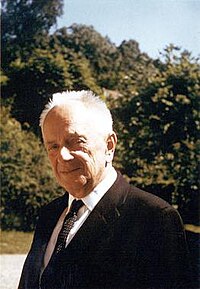Theodosius Dobzhansky
| Theodosius Dobzhansky | |
|---|---|

Theodosius Dobzhansky, c. 1966
|
|
| Born |
Theodosius Grygorovych Dobzhansky January 25, 1900 Nemyriv, Russian Empire |
| Died | December 18, 1975 (aged 75) San Jacinto, California, United States |
| Fields | Evolutionary biology, genetics |
| Institutions |
Taras Shevchenko National University of Kyiv (1921-1924) University of Leningrad (1924-1927) Columbia University (1927-1928, 1940-1962) California Institute of Technology (1928-1940) Rockefeller University (1962-1970) University of California (1971-1975) |
| Alma mater | Taras Shevchenko National University of Kyiv |
| Doctoral advisor | Yuri Filipchenko |
| Notable students | |
| Known for | Bateson–Dobzhansky–Muller model |
| Notable awards |
|
| Spouse | Natalia Sivertzeva (m. 1924, d. 1969) |
Theodosius Grygorovych Dobzhansky ForMemRS (Ukrainian: Теодо́сій Григо́рович Добжа́нський; Russian: Феодо́сий Григо́рьевич Добржа́нский; January 25, 1900 – December 18, 1975) was a prominent American geneticist and evolutionary biologist, and a central figure in the field of evolutionary biology for his work in shaping the unifying modern evolutionary synthesis. Dobzhansky was born in Ukraine, then part of the Russian Empire, and became an immigrant to the United States in 1927, aged 27 years old.
His 1937 work Genetics and the Origin of Species became a major influence on the synthesis and was awarded the US National Medal of Science in 1964, and the Franklin Medal in 1973.
Dobzhansky was born on January 25, 1900 in Nemyriv, Russian Empire, currently Ukraine, an only child. His father, Grigory Dobzhansky, was a mathematics teacher, and his mother was Sophia Voinarsky. In 1910 the family moved to Kiev, Russian Empire. At high school, Dobzhansky collected butterflies and decided to become a biologist. In 1915, he met Victor Luchnik who convinced him to specialize in beetles instead. Dobzhansky attended the Kiev State University between 1917 and 1921, where he then studied until 1924. He then moved to Saint Petersburg, Russia, to study under Yuri Filipchenko, where a Drosophila melanogaster lab had been established.
...
Wikipedia
